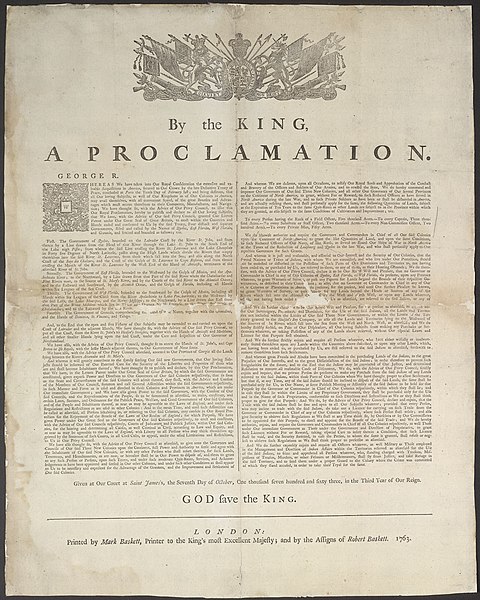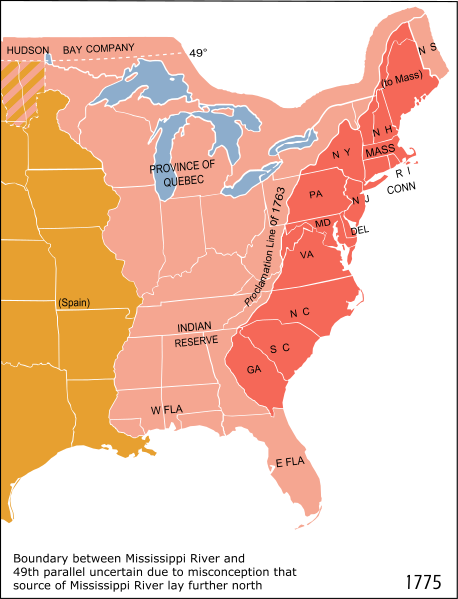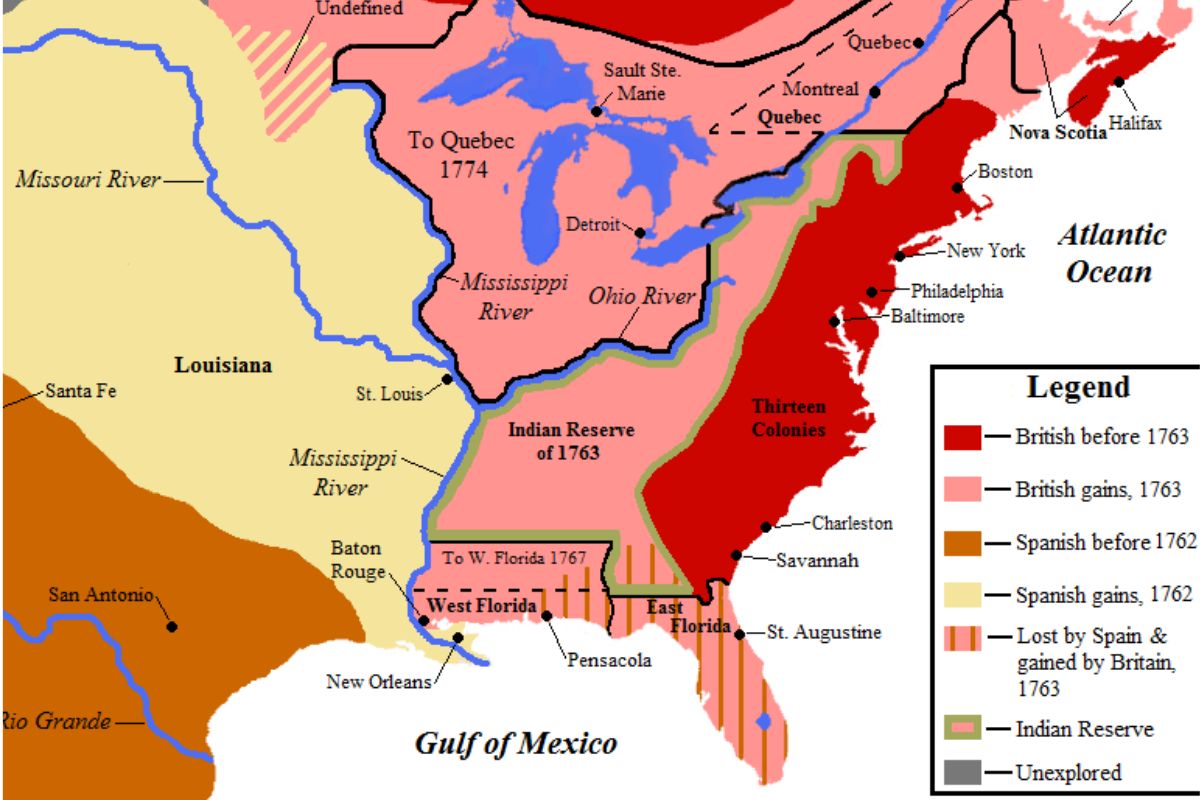The Proclamation of 1763 was a significant event in American history that occurred after the French and Indian War. Issued by King George III, it aimed to regulate the westward expansion of British colonists into newly acquired territories.
The proclamation drew a boundary line along the Appalachian Mountains, reserved the western lands for Native American tribes, and restricted colonial settlement beyond that line.
These measures, along with the enforcement by British troops, led to widespread discontent among the colonists and contributed to their grievances against British rule.
The proclamation set a precedent for future acts that further strained the relationship between Britain and the colonies. Although the proclamation was repealed in 1768, its impact and the underlying tensions it exacerbated played a role in the lead-up to the American Revolution.
Facts about the Proclamation of 1763
1. Issued by King George III
The Proclamation of 1763 was issued by King George III, who became the King of Great Britain in 1760. The proclamation was one of the king’s efforts to maintain control over the American colonies and prevent further conflicts with Native American tribes.

2. The proclamation aimed to regulate the expansion of British colonists into the newly acquired territories
After the French and Indian War, also known as the Seven Years’ War, Britain emerged as the dominant colonial power in North America. The Proclamation of 1763 was enacted to establish British authority and control over the newly acquired territories, particularly those west of the Appalachian Mountains.
By regulating western expansion, the British government sought to maintain stability in the region, prevent conflicts with Native American tribes, and avoid costly military engagements. The proclamation was part of a larger policy of imperial control over the American colonies.
3. The proclamation established a boundary line along the crest of the Appalachian Mountains
The Proclamation of 1763 drew a boundary line along the crest of the Appalachian Mountains, from Maine to Georgia. This line, known as the Proclamation Line, became the western limit of colonial settlement.
The British government intended to reserve the vast western territories for Native American tribes and prevent further encroachment by colonists. It sought to establish a buffer zone between the colonists and Native Americans to reduce conflicts and maintain peace.
The British believed that by restricting colonists to the eastern side of the mountains, they could exert greater control over the western territories and the fur trade.
The proclamation required colonists already living beyond the Proclamation Line to relocate eastward. This displacement caused considerable discontent among those who had already settled in the western territories, leading to protests and defiance of the proclamation’s provisions.
4. The proclamation sought to protect Native American land rights
The Proclamation of 1763 was notable for its recognition of Native American land rights. It aimed to protect the territorial claims and interests of Native American tribes by reserving the western lands for their exclusive use.
The British government hoped that this measure would reduce conflicts between settlers and Native Americans, as well as maintain favorable relations with the tribes.
However, it’s important to note that the proclamation did not fully respect or address the complex relationships between Native American tribes and their territories.
Many Native American nations had longstanding territorial disputes, and the proclamation’s attempt to draw a single boundary line did not account for their diverse and overlapping claims.
Additionally, some Native American tribes had supported the French during the war and felt betrayed by the British’s recognition of their land rights.

5. The proclamation was met with significant resistance and dissatisfaction among many American colonists
The Proclamation of 1763 was met with significant resistance and dissatisfaction among many American colonists. The proclamation was seen as a restriction on their freedom to expand westward, acquire land, and pursue economic opportunities.
It was particularly unpopular among colonists who had already settled in the western territories, as it required them to abandon their homes and move back east of the Proclamation Line.
Many colonists felt that the British government was infringing upon their rights as British subjects and limiting their ability to pursue their own interests and prosperity.
The proclamation fueled a sense of frustration and perceived British oppression, contributing to the growing colonial resentment and desire for greater self-governance.
6. The British government sent troops to enforce the proclamation
To enforce the Proclamation of 1763, the British government dispatched troops to the American colonies. These troops were tasked with preventing further westward expansion by colonists, patrolling the Proclamation Line, and maintaining control over the newly acquired territories.
The presence of British troops on American soil was a source of tension and resentment among the colonists. They viewed it as an intrusion on their liberties and a sign of British oppression.
The deployment of troops to enforce the proclamation marked a significant escalation in the British government’s efforts to exert control over the colonies and enforce its policies, further contributing to the deteriorating relationship between Britain and the colonists.
7. The Proclamation of 1763 was one of several factors that contributed to the grievances of the American colonists against British rule
The Proclamation of 1763 was one of several factors that contributed to the grievances of the American colonists against British rule. It was seen as an example of British policies that disregarded colonial interests and imposed restrictions on their ability to govern themselves and pursue their economic goals.
The proclamation, along with other measures such as the Sugar Act, Stamp Act, and Townshend Acts, heightened colonial frustrations and deepened the sense of alienation from the British government.
It fueled a growing sentiment among the colonists that they were being treated as second-class citizens and denied the rights and freedoms they believed they were entitled to as British subjects.
8. The proclamation established a precedent for future acts and policies
The Proclamation of 1763 set a precedent for future acts and policies that attempted to regulate and control colonial expansion. The British government, seeking to maintain control over the colonies and alleviate mounting debts from the French and Indian War, continued to enact measures that restricted colonial autonomy and sought to extract revenue from the colonies.
It demonstrated the British government’s willingness to use its authority to limit colonial expansion and assert control over colonial affairs.
This established a pattern that would be followed by subsequent acts, such as the Stamp Act and the Townshend Acts, which imposed taxes and levies on the colonies without their consent.
9. Due to ongoing colonial resistance and political pressure, the British government repealed the Proclamation of 1763 in 1768
Due to ongoing colonial resistance and political pressure, the British government repealed the Proclamation of 1763 in 1768. The repeal came as a response to protests and noncompliance from the colonists, as well as recognition of the impracticality of enforcing the boundary line and the growing desire for westward expansion.
While the repeal temporarily eased tensions, it did not resolve the larger issues that fueled colonial discontent. The colonists’ grievances regarding representation, taxation, and the limitations on their freedom persisted and continued to escalate, ultimately leading to the American Revolution.
10. The Proclamation of 1763 played a role in exacerbating the divisions between Britain and the American colonists
The Proclamation of 1763 had long-term effects on the relationship between Britain and the American colonies. It deepened the divide between the colonists and the British government, further eroding trust and fostering a sense of colonial identity separate from Britain.
The proclamation also set the stage for future conflicts over land and westward expansion in North America.
The desire for access to western lands remained a driving force in American history, and the tension between the colonists’ desire for territorial expansion and the British government’s efforts to control and regulate it would continue to play a significant role in shaping the path toward independence.
Furthermore, the resistance and protests against the proclamation served as early instances of colonial unity and defiance against British authority. They laid the groundwork for the emergence of a collective American identity and the eventual call for independence from British rule. The Proclamation of 1763, in this sense, became one of the catalysts for the American Revolution.
